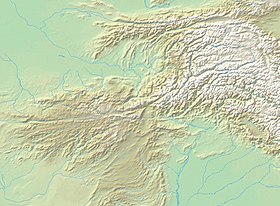Lawik dynasty
Lawik dynasty | |||||||||||||
|---|---|---|---|---|---|---|---|---|---|---|---|---|---|
| c.750 CE–977 CE | |||||||||||||
 Ghazni was the power-center of the Lawik dynasty.
| |||||||||||||
 LAWIK DYNASTY SAMANIDS ABBASID CALIPHATE | |||||||||||||
 SAMANID DYNASTY SAMANID DYNASTY Hund | |||||||||||||
| Capital | Ghazni, Afghanistan | ||||||||||||
| Government | Monarchy | ||||||||||||
| Historical era | Early Middle Ages | ||||||||||||
• Established | c.750 CE | ||||||||||||
• Disestablished | 977 CE | ||||||||||||
| |||||||||||||
| Today part of | Afghanistan | ||||||||||||
The Lawīk dynasty or Lōyak dynasty was based in Ghazni and Gardez, present-day Afghanistan. The Lawik were closely related to the Turk Shahi dynasty.
The Siyasatnama of Nizam al-Mulk, the Tabaqat-i Nasiri of Juzjani, and the Majma' al-ansāb fī't-tawārīkh of Shabankara'i (14th century) mentioned Lawiks.
Wujwir Lawik[]
According to Afghan historian Abdul Hai Habibi, Wujwir Lawik built a great idol-temple at Bamyan Gate, Ghazni in honor of the Ratbil and the Kabul Shah.[1]
Khanan Lawik[]
Wujwir's son, Khanan (referred to as Khaqan in Zayn al-Akhbar), converted to Islam around 782 but then became an apostate. Around 784, Khanan demolished the idol-temple and buried his father's idol underneath it, converting the site into a mosque.
Khanan was sent a poem by the Kabul Shahis, saying: "Alas! The idol of Lawik has been interred beneath the earth of Ghazna, and the Lawiyan family have given away [the embodiment of] their kingly power. I am going to send my own army; do not yourself follow the way of the Arabs [i.e. Islam]."[2]
Abu Mansur Aflah[]
According to Zayn al-Akhbar, written by historian Abu Sa'id Gardezi, Abu Mansur Aflah Lawik was reduced to a tributary status in Gardez by Emir Ya'qub ibn al-Layth al-Saffar in 877.[3]
Around this time nevertheless, it is thought that the Lawik dynasty remained as a ruling family under the suzerainty of the Hindu Shahis.[4]
Abu Bakr Lawik[]
In 962, the Turkic slave commander of the Samanid Empire, Alp-Tegin, attacked Ghazni and besieged the Citadel of Ghazni for four months. He wrested the town from its ruler Abu Bakr Lawik. Alp-Tegin was accompanied by Sabuktigin during this conquest.[5]
Around 965, Abu Bakr Lawik recaptured Ghazni from Alp-Tegin's son, Abu Ishaq Ibrahim, forcing him to flee to Bukhara. However, this was not to last long because Abu Ishaq Ibrahim shortly returned to the town with Samanid aid, and took control of the town once again. Abu Bakr Lawik was thereafter no longer mentioned; he died before 977, the year that Ghaznavid control was established in Ghazni.
Although Juzjani gave Abu Bakr Lawik the Islamic kunya of Abu Bakr, Shabankara'i claimed he was a non-Muslim.[6]
Abu Ali Lawik[]
Abu Ali Lawik was the son of Abu Bakr Lawik,[7] and also a brother-in-law of the Turk Shahi ruler of the region, Kabul Shah.[8]
About one decade after Abu Ishaq Ibrahim's capture of Ghazni, the people of Ghazni invited Abu Ali Lawik to come back, take the throne, and overthrow the tyrant Samanid-appointed governor, Böritigin. The Kabul Shahis allied with Lawiks and the king, most likely Jayapala, sent his son to assist Lawiks in the invasion. When the allied forces reached near Charkh on Logar River, they were attacked by Sabuktigin who killed and captured many of them while also capturing ten elephants. Böritigin was expelled and Sabuktigin became governor in 977 A.D. The accession was endorsed by the Samanid ruler Nuh II.[9]
Later Lawiks[]
On the other hand, the neighboring town of Gardez remained in Lawik hands until c. 977, when the dynasty was finally uprooted. Samanid-appointed governor Bilgetegin was killed by Lawiks during his siege of Gardez in 975.[10]
Abu Sahal Marsal[]
According to Zayn al-Akhbar, Abu Sahal Marsal Lawik served as the ambassador of the court of Ghazni in Baghdad, and brought letters and robes of honor from the Abbasid Caliphate for the Ghaznavid Sultan Mas'ud I in 1040.
See also[]
- Turk Shahi
- Ghaznavids
- Samanids
References[]
- ^ The Islamic Quarterly, Volumes 7-10. London, England: Islamic Cultural Centre. 1963. p. 19.
- ^ Clifford Edmund Bosworth (1977). The Medieval History of Iran, Afghanistan, and Central Asia. Variorum Reprints. pp. 301–302.
- ^ Clifford Edmund Bosworth (1977). The Medieval History of Iran, Afghanistan, and Central Asia. Variorum Reprints. pp. 302–303.
- ^ Petrie, Cameron A. (28 December 2020). Resistance at the Edge of Empires: The Archaeology and History of the Bannu basin from 1000 BC to AD 1200. Oxbow Books. p. 92. ISBN 978-1-78570-306-5.
- ^ John Andrew Boyle (1968). The Cambridge History of Iran, Volume 5. Cambridge University Press. p. 165. ISBN 9780521069366.
- ^ Clifford Edmund Bosworth (1977). The Medieval History of Iran, Afghanistan, and Central Asia. Variorum Reprints. p. 298.
- ^ Mishra, Yogendra (1972). The Hindu Sahis of Afghanistan and the Punjab, A.D. 865-1026: A Phase of Islamic Advance Into India. Vaishali Bhavan. p. 102.
- ^ The wonder that was India II by S A Rizvi Published by Picador India Page 12
- ^ Ramesh Chandra Majumdar (1966). The History and Culture of the Indian People: The struggle for empire. Bharatiya Vidya Bhavan. p. 3.
- ^ Bosworth, C.E. (1992). History of Civilizations of Central Asia. Motilal Banarsidass Publ., 1992. p. 96. ISBN 9788120815957.
| History of Afghanistan |
|---|
 |
| Timeline |
| Related historical names of the region |
| Related topics |
|
- Medieval Afghanistan